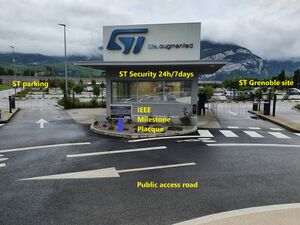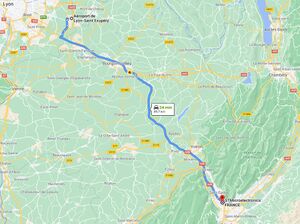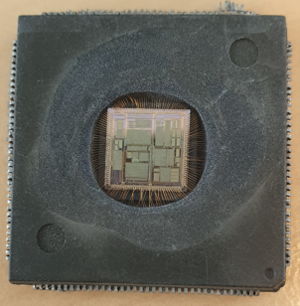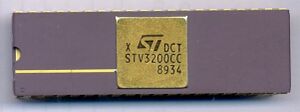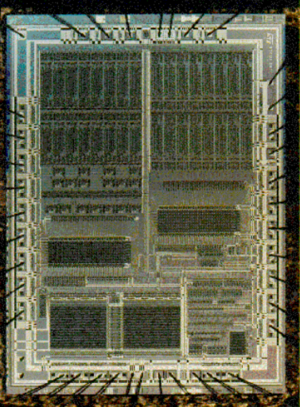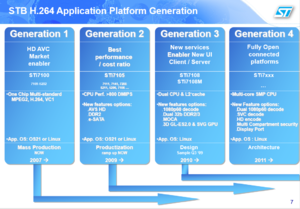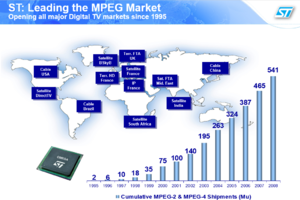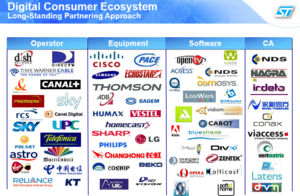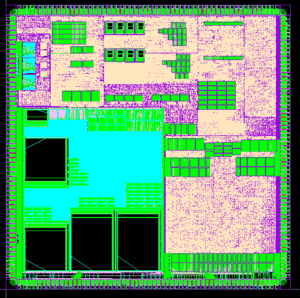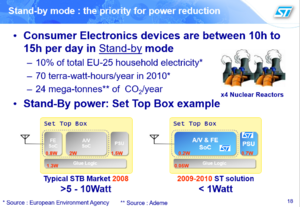Milestone-Proposal:MPEG integrated circuits
To see comments, or add a comment to this discussion, click here.
Docket #:2021-10
This Proposal has been approved, and is now a Milestone
To the proposer’s knowledge, is this achievement subject to litigation? No
Is the achievement you are proposing more than 25 years old? Yes
Is the achievement you are proposing within IEEE’s designated fields as defined by IEEE Bylaw I-104.11, namely: Engineering, Computer Sciences and Information Technology, Physical Sciences, Biological and Medical Sciences, Mathematics, Technical Communications, Education, Management, and Law and Policy. Yes
Did the achievement provide a meaningful benefit for humanity? Yes
Was it of at least regional importance? Yes
Has an IEEE Organizational Unit agreed to pay for the milestone plaque(s)? Yes
Has the IEEE Section(s) in which the plaque(s) will be located agreed to arrange the dedication ceremony? Yes
Has the IEEE Section in which the milestone is located agreed to take responsibility for the plaque after it is dedicated? Yes
Has the owner of the site agreed to have it designated as an IEEE Milestone? Yes
Year or range of years in which the achievement occurred:
1984-1993
Title of the proposed milestone:
MPEG Multimedia Integrated Circuits, 1984-1993
Plaque citation summarizing the achievement and its significance; if personal name(s) are included, such name(s) must follow the achievement itself in the citation wording: Text absolutely limited by plaque dimensions to 70 words; 60 is preferable for aesthetic reasons.
Beginning in 1984, Thomson Semiconducteurs (now STMicroelectronics) developed multimedia integrated circuits, which accelerated Moving Picture Experts Group (MPEG) standards. By 1993, MPEG-2 integrated decoders -- including innovative discrete cosine transform (developed jointly with ENST, now Telecom ParisTech), bitstream decompression, on-the-fly motion compensation, and display unit -- were announced in one silicon die: the STi3500. Subsequent MPEG-2 worldwide adoption made compressed full-motion video and audio inexpensive and available for everyday use.
200-250 word abstract describing the significance of the technical achievement being proposed, the person(s) involved, historical context, humanitarian and social impact, as well as any possible controversies the advocate might need to review.
IEEE technical societies and technical councils within whose fields of interest the Milestone proposal resides.
In what IEEE section(s) does it reside?
France Section
IEEE Organizational Unit(s) which have agreed to sponsor the Milestone:
IEEE Organizational Unit(s) paying for milestone plaque(s):
Unit: France
Senior Officer Name: Claire LAJOIE-MAZENC
IEEE Organizational Unit(s) arranging the dedication ceremony:
Unit: France with STMicroelectronics
Senior Officer Name: Claire LAJOIE-MAZENC
IEEE section(s) monitoring the plaque(s):
IEEE Section: France
IEEE Section Chair name: Claire LAJOIE-MAZENC
Milestone proposer(s):
Proposer name: Danilo Pau
Proposer email: Proposer's email masked to public
Proposer name: Jean-Michel Moutin
Proposer email: Proposer's email masked to public
Please note: your email address and contact information will be masked on the website for privacy reasons. Only IEEE History Center Staff will be able to view the email address.
Street address(es) and GPS coordinates in decimal form of the intended milestone plaque site(s):
(45.203333, 5.695833)
Describe briefly the intended site(s) of the milestone plaque(s). The intended site(s) must have a direct connection with the achievement (e.g. where developed, invented, tested, demonstrated, installed, or operated, etc.). A museum where a device or example of the technology is displayed, or the university where the inventor studied, are not, in themselves, sufficient connection for a milestone plaque.
Please give the details of the mounting, i.e. on the outside of the building, in the ground floor entrance hall, on a plinth on the grounds, etc. If visitors to the plaque site will need to go through security, or make an appointment, please give the contact information visitors will need. The Grenoble site is of premier importance for STMicroelectronics. It was owned by THOMSON SEMICONDUCTEURS, then merged with SGS in 1987 to form SGS-Thomson. Nowadays is the biggest R&D site of the company, hosting many product divisions from the three Product Groups of the company, including silicon and software design, test, and advanced packaging developments. In this site MPEG chips were conceived and designed
Are the original buildings extant?
Yes, even if part of them were restructured they still exists @ STMicroelectronics, 12, rue Jules Horowitz F-38000 Grenoble, France
Details of the plaque mounting:
Plaques will be installed in a public place at the main entrance as shown in figure 1. It will be in front of company security personnel who are monitoring entrance 24 hours in a day, every day in a year. Very close as indicated there is the public road. Plaque will be placed at 12, rue Jules Horowitz F-38000 Grenoble, France. GPS coordinates are: 45°12’12” N ; 05°41’45” E (45.203333, 5.695833). Therefore, interested visitors will not need to be escorted by the company security personnel to watch the plaque or to take a photo with it. The milestone plaque will be installed right in front of the main entrance access. It is where employees, visitors and customers must pass through to get into the Grenoble offices on daily basis. It is monitored continuously 24h/7d by security human resources and surveillance camera. It is a public place, right outside the site restricted perimeter.
How is the site protected/secured, and in what ways is it accessible to the public?
It is protected by company security human resources and with surveillance camera, 24h/7d. It is publicly and easily accessible from 12, rue Jules Horowitz F-38000 Grenoble, France. The site can be reached also from Lion Airport, close to Grenoble as shown in figure 2.
Who is the present owner of the site(s)?
STMicroelectronics (Grenoble 2) SAS
What is the historical significance of the work (its technological, scientific, or social importance)? If personal names are included in citation, include detailed support at the end of this section preceded by "Justification for Inclusion of Name(s)". (see section 6 of Milestone Guidelines)
The importance of the proposed milestone will be described as follows: section 1 introduces the object; section 2 lists the technical innovations; section 3 discusses the benefits of the innovations and section 4 their achievements; section 5 provides the historical background about when the innovations were introduced; Section 6 reports the public recognition of the integrated circuits by specialized journals. Finally, section 7 is for the supporting letters provided by world renown experts.
1) Object of the milestone proposal
Starting from 1984 new digital multimedia technologies were conceived and implemented by SGS-THOMSON on different CMOS silicon technologies. They were dedicated processors very optimized in area and power consumption. They were hand-designed and produced in high volume, with high yields and reliability to achieve lowest cost. Next, they were incrementally super-integrated in one silicon die to perform multimedia video decoding anticipating specifications as established by MPEG in the 1992 onward. Several innovations were introduced to reduce the complexity due to the super integration. They anticipated the acceleration of the MPEG1, 2 and subsequent standards. Since no digital multimedia content services for moving pictures were existing at that time, they set the hardware to introduce them. They facilitated widespread adoption by the end users and eased switch-off from analog decoders to digital ones. A special mention is for the STi3500 chip which was the world first MPEG2 decoder. The chip die is shown in the figure 3.
2) Technical innovations introduced by the milestone
The circuits introduced several innovations. They were:
a) Block based pixel memory management to achieve closely the peak computational power.
b) Compressed MPEG decoding on the fly to reduce video storage in RAM.
c) Frame buffer lossy compression to co-decompress on the fly MPEG2 video
d) Unified memory controller allowed to plug and play additional MPEG and other hardware clients.
3) Benefits of the innovative solutions subject of the milestone
The benefits of integrated circuits which embodied innovations described in section 2, were:
a) Transistor count minimization to ease super integration in one silicon die.
b) Hand crafted hardware design methodology to produce very tiny circuits.
c) Energy consumption to less than one watt across chip generations.
d) Reliability to produce chips for widespread adoption
e) Resilience to faults.
4) Technical achievements of the proposed milestone
The achievements of the processors of the milestone were on the following key indicators:
a) Performances (highest degree of acceleration of MPEG functionalities).
b) Manufacturability (reliability, repeatability, high volumes, robustness, high yields)
c) Super integration of RAM.
d) Silicon node scaling from 2µm to 28nm FDSOI (fully depleted silicon on insulator).
e) Flexibility (VLIW processors, CPUs, 3D programmable graphic)
f) Security (data and memory protection encryption).
g) Efficiency (mW/sqmm/$, reduced memory bandwidth, and reduced calculations bit-depth)
h) Tiny dissipation (avoided costly and bulky heat-sinks and complex liquid cooling)
l) Costs (cheap solutions for end users, eased TV set manufacturers to achieve large scale savings)
m) Ecosystem (key enabler of broad range digital video applications and digital multimedia vertical services, facilitated the end user to enter the new digital entertainment era)
5) Historical background and contributions
THOMSON Semiconductor (headquarter in Grenoble, France) was merged with SGS (headquarter in Agrate Brianza Italy) in 1987; the merge was named SGS-THOMSON; then the company was renamed in 1998 as STMicroelectronics (today name).
In the late 1980s ISO/IEC experts felt the need to standardize motion picture decoding. Therefore, MPEG committee had first meeting in 1988. MPEG1 standard was finalized in 1992 and MPEG2 was finalized in 1994.
All MPEG integrated circuits, object of this proposed milestone, are developed fully in-house SGS-THOMSON Grenoble and intellectual properties are owned by STMicroelectronics.
Next points a) to d) details that the technology subject of this proposed milestone, the MPEG circuits :
a) In 1984, THOMSON Semiconductors started to develop own Discrete Cosine Transform (DCT). This effort was patented twice, therefore the company decided to launch an own chip design and production project in 1986.
b) In 1986 ENST (now Telecon ParisTech) had in parallel a DCT experiments based on a less hardware efficient algorithm than THOMSON designed.
c) In 1987, THOMSON Semiconductor and ENST, even if not essential to DCT chip, decided to cooperate on redesigning a part of the whole DCT chip. The operative part with a serial architecture was conceptualized by ENST and designed by THOMSON in hardware.
d) In 1988 SGS-THOMSON had following products ready for production
i. STV3200 the multi format DCT, not MPEG compliant
ii. STV3208 8x8 DCT, MPEG compliant. Note that DCT into modern chips was just 0.05% of total chip area
Next points aim to explain how MPEG chips were developed.
e) First MPEG1/H261 standard compliant . First solution was composed by two integrated circuits: the picture motion compensation, huffman decoding, dequantization, memory control (into STi3240) and the 8x8 DCT (STV3208). Second solution was the super integration of the two circuits into a single chip named STi3400 .
f) World first STi3500 MPEG2 decoder circuit. It integrated STV3208 with MPEG2 compliant motion compensation. RCA, later acquired by Thomson Consumer Electronics, was creating the world first Digital Satellite TV broadcast service but missed the video decoding function. STi3500 was delivered to RCA (ahead of the competition) and enable decoding of the DirectTV digital multimedia broadcast. Next STI3520A was the world first single chip for MPEG 2 video decoding in only 16 Mbit RAM super integrated with the world first MPEG MP3 Audio decoder (STi4500).
g) First HDTV decoder circuit with RAM reduction algorithms integrated: the STi7000 in 1998. Next versions STi7100, STi7200 integrated 3D shader-based graphics engine and powerful micro controllers. STi7108 had dual CPU host processors with embedded memory. It was the first circuit in the world to integrate 3D OpenGL-ES 2.0 and OpenVG vector graphics.
h) STi5500 was the first (after signal demodulation circuit) complete decoder for set-top boxes and DVD players. Capable to demux MPEG2 transport stream. Memory compression algorithms reduced its RAM needs.
i) World first STi5505, that integrated all the back-end functions of a DVD player. More powerful than the STi5500 and capable to support MPEG2 program stream demultiplexing inside. STi5500 won from a field of nearly 300 nominations, the prestigious European IT Prize awarded by the European Commission in conjunction with Euro-CASE, the European Council of Applied Science and Engineering. Its further evolutions were STi5600 and STi5610.
l) Further generations. Many other integrated circuits were designed over 30 years, as shown in figure 7. Complex operative systems such as Linux and Windows were incrementally supported. These processors also pioneered TV Cable transmission with Scientific Atlanta (which was acquired by Cisco later). They accelerated the introduction of CD-ROM, DVDs, Set Top Box and digital TVs home systems. The analog to digital entertainment switch was therefore supported by mass production circuits and doable in everyone home.
Since the functionalities they integrated, these chips were deployed also into smartphones since early 2000s. The Nomadik chip family (STn8800/10/15 and subsequent) was derived to accelerate multimedia into mobile phones. The pioneering 8x8 MPEG DCT chip, the STV3208, represented less than 0.1% of the die area of the SoC as shown in figure 8.
ST manufactured more than 500 million (cumulative number) of these integrated systems worldwide as shown in Figure 9.
A rich digital consumer ecosystem has been created thanks to those circuits. It was composed by many operators, equipment manufacturers, software developers and conditional access companies as shown in the next figure 10.
7) Public recognition of the integrated circuits Specialize magazines reported the leadership of the MPEG circuits.
a) EETimes article “In the first shift or wave (referred to in the set-top box market), which began about 1994, the boxes were simple channel-hopping devices for satellite and cable TV providers, Hatch explained. (STMicroelectronics's MPEG-2 video decoders were used then in the boxes manufactured by Thomson's RCA subsidiary.)”.
b) EDN article on 1996 “Dataquest has confirmed SGS-THOMSON Microelectronics (Lincoln, MA) as the world's leading supplier of MPEG decoder ICs in 1995.”
c) STMicroelectronics NV History quoting “ STMicroelectronics is the world's leading manufacturer of .... MPEG-2 decoder chips, used to provide video decompression for DVD players and digital television set-top boxes.” and “Another area in which SGS-Thomson became an early player was its development of MPEG decompression chips. The company's dedication to MPEG technology was risky, as a number of other digital video decompression schemes were competing for what promised to be a huge market in the future. SGS Thomson gained an early lead in the MPEG market. By 1993, the company had debuted its "multimedia" chip, capable of decompressing digital video files for display on a television set. This chip helped the company take a major position in the new set-top box market, starting with supplying the chip for the Hughes digital satellite television set-top box.”
8) Supporting letters by world renown and independent experts in the field Please refer to part 7 of bibliography
What obstacles (technical, political, geographic) needed to be overcome?
1) Technical obstacles
Several obstacles were addressed. Hereafter associated solutions will be discussed in the following order: a) Silicon; b) Algorithm; c) Hardware; d) Memory reduction, e) Power consumption; f) User experience.
a) Silicon technology
One key initial obstacle was represented by the low density 2 and 1.25 um CMOS silicon technology that limited circuity complexity and super-integration. SGS-THOMSON hardware designers overcome this barrier by hand crafting the design, making it very efficient and low transistor count. A careful decision was about which functions to accelerate with respect to the ones to execute in software. As result, STV3208 needed only 115,000 transistors for 8x8 MPEG DCT. Multiple technical dimensions were addressed such as:
i) data precision of internal calculations, as low as 8 bits. DCT coefficients were coded with only 12bits to reduce RAM. Data have been also processed at 16 bits. This avoided 32bits integer and floating point arithmetic.
ii) Designed circuits to be compliant with IEEE 1180-1990, the IEEE Standard Specifications for the Implementations of 8x8 Inverse Discrete Cosine Transform.
iii) Internal memory distribution. Transposition of read and write memory data access avoided costly RAM. DCT separability was exploited to save silicon area. Integrated RAM was as low as 4Kbits.
iv) Design flexibility. Its design was capable to support specifications as established by MPEG-1, 2, 4, H.264 and HEVC standards with a plug and play of new accelerators thanks to the unified memory controller architecture.
b) Hardware technology
The software computing bottleneck was solved by hardwiring DCT, variable length coding, motion compensation, de quantization processing functions. It removed the need for any time critical handshake between the external micro controller and the integrated circuits. Achieved performances order of magnitude higher than pure software execution.
d) Memory reduction technology
A major obstacle was the cost of the RAM . Super integration required unified memory management. Many accelerators super integrated were contending memory access simultaneously. Decoding PAL and NTSC resolutions was achieved into only 16 Mbits with several memory tricks. Novel memory reductions technique fixed the obstacle allowing MPEG SD decoding as low as 8Mbits and HTDV in 32Mbits. In figure 11 the picture of the first consumer high-definition MPEG video chip. The Motion compensation unit with memory reduction is the block on the bottom right corner, with a raw of memory at the bottom and two almost parallel rows on the top. These are mostly due to memory related to data management for decompression.
e) Power consumption limitation
The integrated chips were consuming as low as between 0.5 to 1 W (figure 12).
f) User experience
It required high quality images blended with real time 2D/3D graphics (figure 13). Integrated powerful image blitters, on screen display processors, 3D shader based, and 2D vector graphics engines provided the support for user interfaces, internet browsers, gaming, and 3D TV. These chips were the 1st in offering to the digital consumer market by implementing OpenGL-ES and OpenVG graphic standards as established by the Khronos group.
2) Organizational obstacles
Management was uncertain at the beginning to invest too much into the development of a full roadmap of multimedia circuits.
a) Management commitment
In late 1980s the digital multimedia satellite/cable/terrestrial/streaming video and audio services were not existing. Analog TV transmissions were dominating the market and in everyone home, while the PC was marginal for that domain. Therefore, the company management was reluctant to start investing in developing multimedia chips with an unpredictable return on investments. The internal investments were purely R&D generating only financial losses. However, the design win achieved with RCA/DirecTV with the STi3500 was a cornerstone, and convinced to invest more resources (figure 14). This achievement marked the end of the 10 years pioneering phase by the company.
What features set this work apart from similar achievements?
They were: a) accuracy of results provided by the chips, b) their maturity, and d) the advancements they featured.
a) Accuracy of results ST chip without visible mismatch errors versus anchor’s references as established by MPEG core experiments
b) Chip maturity: SGS-Thomson chips were released earlier and the more mature vs Toshiba, Fujitsu, Telettra, ANT, C-Cube. c) Chip Advancements. They significantly provided low silicon area footprint by exploiting advanced CMOS silicon lithography such as 0.8, 0.5, 0.35um up to 28nm FDSOI.
Why was the achievement successful and impactful?
Supporting texts and citations to establish the dates, location, and importance of the achievement: Minimum of five (5), but as many as needed to support the milestone, such as patents, contemporary newspaper articles, journal articles, or chapters in scholarly books. 'Scholarly' is defined as peer-reviewed, with references, and published. You must supply the texts or excerpts themselves, not just the references. At least one of the references must be from a scholarly book or journal article. All supporting materials must be in English, or accompanied by an English translation.
1) Technical articles, conference papers & books
[1.1] A. Artieri, S. Kritter, F. Jutand and N. Demassieux, "A one chip VLSI for real time two-dimensional discrete cosine transform," 1988., IEEE International Symposium on Circuits and Systems, 1988, pp. 701-704 vol.1, doi: 10.1109/ISCAS.1988.15022.
[1.2] STV3200 DISCRETE COSINE TRANSFORM (DCT) Datasheet
[1.3] A. Artieri and O. Colavin, "A chip set core for image compression," in IEEE Transactions on Consumer Electronics, vol. 36, no. 3, pp. 395-402, Aug. 1990, doi: 10.1109/30.103150.
[1.4] STi3400 MPEG/H.261 VIDEO DECODER DATASHEET
[1.5] STi3500 MPEG2 CCIR 601H.261 VIDEO DECODER DATASHEET
[1.6] Image and Video Compression standards: algorithm and architectures, Bhaskaran, Vasudev, Konstantinides, Konstantinos, ISBN 978-1-4615-6199-6, 1995
[1.7] K. Konstantinides and V. Bhaskaran, "Monolithic architectures for image processing and compression," in IEEE Computer Graphics and Applications, vol. 12, no. 6, pp. 75-86, Nov. 1992, doi: 10.1109/38.163627.
[1.8] STi70000 press release
[1.9] STi71000 datasheet
[1.10] STi7200 datasheet
[1.11] STi7108 datasheet
[1.12] STi7108 processor with 3D graphics made public.
[1.13] A chip set for MPEG-2 video encoding; Proceedings of the IEEE 1995 Custom Integrated Circuits Conference, 1995
[1.14] STi3240 MPEG1/H261 datasheet
[1.15] STi3208 DCT chip datasheet
[1.16] STi3520A MPEG2 chip datasheet
[1.17] STi5600 MPEG2 chip datasheet
[1.18] STi5610 MPEG2 chip datasheet
[1.19] F. Jutand, N. Demassieux, G. Concordel, J. Guichard and E. Cassimatis, "A single chip video rate 16×16 discrete cosine transform," ICASSP '86. IEEE International Conference on Acoustics, Speech, and Signal Processing, 1986, pp. 805-808, doi: 10.1109/ICASSP.1986.1169147.
[1.20] N. Demassieux, G. Concordel, J. Durandeau and F. Jutand, "An optimized VLSI architecture for a multiformat discrete cosine transform," ICASSP '87. IEEE International Conference on Acoustics, Speech, and Signal Processing, 1987, pp. 547-550, doi: 10.1109/ICASSP.1987.1169851.
[1.21] Tomasko, M., Buchhauser, D., Bushroe, M. et al. The Descent Imager/Spectral Radiometer (DISR) Experiment on the Huygens Entry Probe of Titan. Space Science Reviews 104, 469–551 (2002). https://doi.org/10.1023/A:1023632422098
[1.22] Report of the meeting of the DCT chip manufacturers in Martlesham UK 24-25 May 1988, CCITT SGXV Document #349, Working Party XV/1 21 June 1988, Specialists Group on Coding for Visual Telephony
[1.23] An Integrated MPEG-1 and MPEG-2 Decoder, IEEE International Conference on Consumer Electronics, 21-23 June 1994 https://ieeexplore.ieee.org/document/582280
[1.24] Progress on Inverse DCT Accuracy Specifications, C.C.I.T.T. Study group XV WP XV/1 Specialist Group on Picture Coding
[1.25] Matrix multiplier transform analysis and design of a general purpose transformer; Signal Processing, Volume 28, Issue 2, August 1992, Pages 153-162 https://doi.org/10.1016/0165-1684(92)90032-R
2) Online information and citations
[2.1] https://en.wikipedia.org/wiki/Motorola_68020
[2.2] https://techmonitor.ai/technology/sgs_thomson_debuts_one_chip_hdtv_system
[2.3] Leonardo Chiariglione awards https://leonardo.chiariglione.org/public-life/awards/
[2.4] see pdf and https://www.eetimes.com/apis-help-stmicroelectronics-grow-set-top-box-business/#
[2.5] see pdf and https://www.edn.com/sgs-thomson-microelectronics-named-number-one-mpeg-decoder-supplier-by-dataquest/
[2.6] see pdf and http://www.fundinguniverse.com/company-histories/stmicroelectronics-nv-history/
[2.10] http://ciclops.org/ir_index/208/In-Orbit?js=1
[2.11] https://en.wikipedia.org/wiki/Allan_Alcorn
[2.12] https://www.amazon.com/dp/B096G6TSF9/
[2.13] Computer History Museum, Oral History of Allan Alcorn Recorded: April 26, 2008 and May 23, 2008 Mountain View, California https://archive.computerhistory.org/resources/access/text/2012/09/102658257-05-01-acc.pdf
3) STMicroelectronics documents
[3.1] De la Transformée en Cosinus Discrète aux Processeurs Applicatifs Multimédia, Alain Artiéri, Septembre 2007, STMicroelectronics presentation
4) Patents
[4.1] USRE34734 "Integrated digital signal processing circuit for performing cosine transformation”
[4.2] US4872134A "Signal processing integrated circuit for row and column addition of matrices of digital value”
[4.3] US5600837A "Multitask processor architecture having a plurality of instruction pointers”
[4.4] Integrated signal processing circuit for online and column summation of digital value matrices https://patents.google.com/patent/FR2608802B1/en?inventor=alain+artieri&oq=alain+artieri&sort=old
[4.5] Transposition memory for data processing circuit https://patents.google.com/patent/FR2617621B1/en?inventor=alain+artieri&oq=alain+artieri&sort=old
[4.6] Method and apparatus for addressing a memory area of an MPEG decoder
[4.7] publication number US6081298A MPEG decoder with reduced memory capacity
[4.8] publication number 0 298 002 of 29.06.1988 Memoire de transposition pour circuit de traitement de donnes
[4.9] publication number FR2649226A1 BREWING CIRCUIT OF DATA
[4.10] publication number FR2650462B1 Device for converting a line scanning into a scanning in vertical saw teeth by bands; https://patents.google.com/patent/FR2650462B1/en?q=H04N3%2f30&inventor=alain+artieri&sort=old
[4.11] publication number EP0368731B1 Process and circuit for image representation signal filtration
[4.12] Circuit pour effectuer une transformation linéaire sur un signal numérique Patent issuer and number eu EP 0241352 A1 https://patents.google.com/patent/EP0241352A1
[4.13] Additionneur binaire comportant un opérande fixé, et multiplieur binaire parallèle-série comprenant un tel additionneur Patent issuer and number eu EP 0262032 B1 https://patents.google.com/patent/EP0262032B1
[4.14] Integrated digital signal processing circuit for performing cosine transform
[4.15] Signal processing integrated circuit for row and column addition of matrices of digital values
5) Honors
[5.1] Two European IT Prizes Awarded to STMicroelectronics
6) MPEG mentions
[6.1] Chiariglione and the birth of MPEG https://www.chiariglione.org/public-life/media/leonardo_ieee/prof.htm
7) Letters of support
[7.1] By Alain ARTIERI, the creator of MPEG2 chips in ST.
[7.2] Endorsement by Nicolas Demassieux, Senior Vice President of Research, Orange, assistant professor at ENST (now Telecom ParisTech) mid 80s.
[7.3] Endorsement by Leonardo Chiariglione, PhD Eng, the father of MPEG
[7.4] Endorsement by Professor Emeritus Fabio Rocca, Politecnico di Milano, pioneer of motion estimation in 1969
[7.5] Endorsement by Hisafumi Yamada, former Sony US TV CTO
[7.6] Endorsement by Sylvain Kritter, Product Director VIZYON
[7.7] Endorsement by Professor Emeritus Virginio Cantoni, University of Pavia. Also Fellow of the IAPR since 1994 and Life Fellow of the IEEE (he was Fellow since 1997). In 2006 the President of the Italian Republic conferred to Professor Virginio Cantoni the title of ‘Commander of the Order of Merit of the Italian Republic’.
[7.8] Endorsement by Professor Emeritus Mariagiovanna Sami, Politecnico di Miano. Past Full Professor, Digital Systems. IEEE Life Member. Minerva prize for woman scientists, the Seymour Cray prize for contributions in the area of parallel processing, the Herbert A. Simon Gold Medal, assigned by the Society for Design and Process Science. Cavaliere della Repubblica Italiana (knight of the Italian republic). Member of the Italian National Science Academy (“Dei Quaranta”).
[7.9] Endorsement by Professor Andrea Basso who directly contributed to MPEG standards since 90s while in EPFL and in AT&T Bell labs and AT&T Research Laboratories, Middletown, NJ, USA
[7.10] Endorsement by Allan Alcorn, Apple Fellow in the late 80s in the Advanced Technology Group at Apple Computer, Cupertino USA
[7.11] Endorsement by Jeff Cooper, former Senior R&D Engineer at Thomson Multimedia - RCA in the 90s responsible for DirectTV MPEG2 set top box design based on STi3500.
[7.12] Endorsement by Shigenobu Minami, former R&D team leader at Toshiba for MPEG4 standardization and LSI planning in the 90s.
Supporting materials (supported formats: GIF, JPEG, PNG, PDF, DOC): All supporting materials must be in English, or if not in English, accompanied by an English translation. You must supply the texts or excerpts themselves, not just the references. For documents that are copyright-encumbered, or which you do not have rights to post, email the documents themselves to ieee-history@ieee.org. Please see the Milestone Program Guidelines for more information.
Please email a jpeg or PDF a letter in English, or with English translation, from the site owner(s) giving permission to place IEEE milestone plaque on the property, and a letter (or forwarded email) from the appropriate Section Chair supporting the Milestone application to ieee-history@ieee.org with the subject line "Attention: Milestone Administrator." Note that there are multiple texts of the letter depending on whether an IEEE organizational unit other than the section will be paying for the plaque(s).
Please recommend reviewers by emailing their names and email addresses to ieee-history@ieee.org. Please include the docket number and brief title of your proposal in the subject line of all emails.
